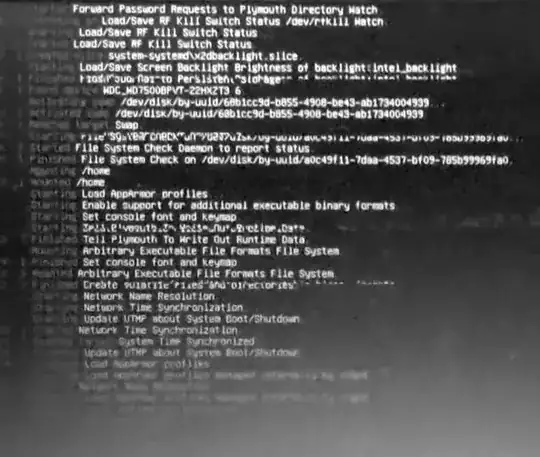Summary of issue:
I had to hard power off my laptop while a program was working with a file, and, upon booting back up, Ubuntu attempted to fix the resulting file system issues. During this process, whatever it is that Ubuntu is doing (see the Detailed information section for more) hangs indefinitely and my laptop never finishes booting. Note that during the first attempt at booting up, while Ubuntu was trying to repair itself, it printed out diagnostic info to the screen regarding orphaned inodes (unfortunately I didn’t pay enough attention to remember exactly what was on screen).
Detailed information:
I'm dual booting Windows 7 and Ubuntu 20.04 on an old Acer Aspire V3-771G.
While working in an IDE I was attempting to remove a few files from my project. The IDE became unresponsive after I confirmed my choice in a dialog box, then my entire system became unresponsive. Now, my laptop is around 10 years old and has its unreliable moments, so this didn’t really phase me. I figured that all my work was saved anyway and hard powered off my laptop after waiting, like, 5 minutes for anything to respond.
When I tried booting back up, after the Ubuntu splash screen and loading spinner, Ubuntu started trying to fix the file system displaying diagnostic info regarding inodes. The process appeared to complete, printing a line that I remember being in the format /dev/sda5: [something], [number]/[number] files, [number]/[number] blocks. After which I was left with a blinking prompt below the last message. Again, my computer became unresponsive.
After waiting another few minutes I hard reset it again, then my laptop settled into the consistent behavior it displays now. Upon trying to boot, Ubuntu displays its splash screen, then, within less than a second, a few screens’ worth of text scrolls by. I'm fairly sure that it's typical boot-up diagnostic info and not relevant to my issue, but I managed to capture a moment of it regardless:
After displaying that text, the screen clears and I'm left with the message /dev/sda5: clean, 231273/1222992 files, 3947028/4882432 blocks and an unresponsive blinking underscore prompt. It may be worth mentioning that this message is different than the one I saw on first boot-up. The numbers were for sure different, but I don't know about the rest of the message.
I've tried:
Being more familiar with Windows than Linux, I am at a loss for how to proceed. Because I don't fully understand the nature of the problem I'm having (beyond the fact that it has to do with my file system), so it's difficult to recognize potential solutions when/if I encounter them by a search engine.
I've tried restarting several times and waiting after the last message appears to no avail.
I've tried booting into Recovery Mode and selecting fsck, but that just yielded the following:
/lib/recovery-mode/recovery-menu: line 80: /etc/default/rcS: No such file or directory
fsck from util-linux 2.34
/dev/sda5 is mounted.
e2fsck: Cannot continue, aborting.
Finished, please press ENTER
I think the issue there was that I was in the drive whose file system needs to be checked and can’t unmount it. Is this correct?
One potential avenue that I found while searching that seems promising though is to boot using an Ubuntu Live USB and run fsck there, but I'd really like to know what commands/arguments to use ahead of time so I can make sure I fix things correctly. Since writing this question, I have tried this and successfully ran fsck where I thought the issue would be and my issue has not been resolved.

sudo nano /etc/sysctl.d/10-magic-sysrq.conf– oldfred Jun 18 '22 at 03:33@user10489 I agree, it seems the problem is unrelated. Could you explain what you mean by "using systemd.unit=multi-usertarget"?
– Sigmatic Jun 18 '22 at 09:36/var/log/nvidia-installer.logfile and put the content in your question. – Raffles Jun 18 '22 at 11:22